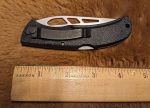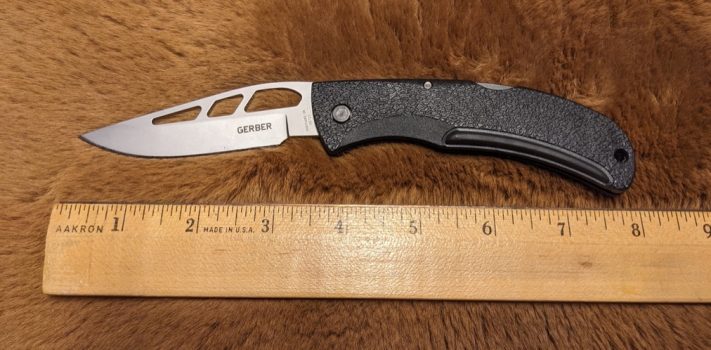The skeletonized spine of the Gerber E-Z Out Skeleton Plain Edge folding knife provides a strong but lightweight blade for this excellent folding knife. Like the Spyderco hole, the cut-outs in the blade provide the thumb with a consistent friction point for reliable ambidextrous one-handed deployment without snagging on clothing or impeding the cutting action of the blade.
The 3.25 inch, 420HC, saber-grind, drop-point blade comes out of the box shaving sharp. Two Kraton SoftGrip inserts provide the slender but sturdy polycarbonate handle with an excellent grip surface.
Priced at $47 at the time of this writing at www.gerbergear.com , the knife provides an outstanding value for an American-made knife.
First Impressions
My daughter, “Ella” and son-in-law, “Sam” gave me an E-Z Out Skeleton for Christmas.
The knife came in a simple 5 x 1.75 x 0.75 inch paperboard box. A sticker on the box identifies the model, and indicates in four languages that it is made in the USA: English, French, German, and Spanish.
The skeletonized spine makes the blade stronger than the blades of most knives of similar weight, and lighter than the blades of most knives of similar size.
 Although the skeletonized spine provides a great deal of strength in the direction in which the blade cuts, it provides less support than a solid spine perpendicular to the direction of cutting. So if you are like me and sometimes use your knife as a prying tool, I would recommend approaching this task with more caution with this knife than you would with a knife with a blade that has a solid spine.
Although the skeletonized spine provides a great deal of strength in the direction in which the blade cuts, it provides less support than a solid spine perpendicular to the direction of cutting. So if you are like me and sometimes use your knife as a prying tool, I would recommend approaching this task with more caution with this knife than you would with a knife with a blade that has a solid spine.
Once opened, the blade is held in place by a sturdy lock-back design. The knife is 4.5 inches closed and 8 inches open and weighs just 2.6 ounces. The bead-blasted finish of the blade is very attractive and practical.
The polycarbonate handle is nicely textured, but I think it would still be just a little too slippery without the excellent Kraton SoftGrip inserts. Many reviewers misidentify the grip as glass-filled nylon. Polycarbonate is generally more durable than glass-filled nylon, but it is also more slippery, especially when wet.
In addition to the knife, the box contains a slip of paper describing the limited lifetime warranty as well as the typical “Captain Obvious” warnings about knives being sharp. The English of the US, Canada, and the UK are close enough that a single warranty and a single warning serve adequately for all three countries. But the French of Canada and France and the Spanish of Mexico and Spain are different enough that these countries merit separate warranties and warnings. Germany also enjoys its own warranty and warning.
The sturdy clip does not allow the knife to sit as deeply in a pocket as some may desire. It peeps out a little too much for those who wish for more subtlety. The lanyard hole is just a little too small to comfortably accommodate paracord.
Testing
I clipped the knife into my left front pants pocket, and carried for the next several weeks. It quickly became one of my favorites.
I like it because it’s light in weight and has a thin profile that have made it easy to carry. It was easy to access other items in my pocket without the knife scraping the back of my left hand.
I found the bead-blasted finish to be more aesthetically pleasing and more durable during use than most other finish alternatives.
Although 420HC is a budget-friendly blade material, I tend to like not only its price but also its performance more than many higher-end blade materials. It is so easy to re-sharpen that I tend to carry out that process more frequently and more effectively than I do with some of my higher-end blades.
I must also admit that I have a special warm spot in my heart for knives that cost less than $50. It seems like a triumph of the knife-maker’s craft to construct a good American-made knife for such a reasonable price.
During the testing period, I used the knife for a variety of the routine tasks of everyday life, including:
- cutting a bad spot out of my apple while eating lunch
- opening bags of salad greens
- opening letters and packages
- removing stickers from packaging to read information that was hidden under the stickers
- slicing leftover ham for an afternoon snack
- slicing cheese to eat with chili and crackers for supper/
At least one task was not routine. Our church decided to remove some pews from one wing of the auditorium and replace them with chairs. This was to allow more flexibility for wheelchair access. I used the knife to remove some plugs that covered the access holes in the pews where they were attached to the floor. This allowed us to unbolt the pews from the floor.
 We listed the pews that we had removed on Facebook Marketplace. One person came in a pickup truck to get 2 of the pews. Unfortunately, the pews were too long to safely carry in the bed of the truck. The person was planning to use the pews as a wood source for a craft project rather than for seating. So we decided to cut the pews in half in order to better fit in the bed of the truck. I used the knife to cut away two sections of the pew cushions in order to keep the cushions from snagging a saw blade. I am happy to report that slashing pew cushions is not a routine task for me.
We listed the pews that we had removed on Facebook Marketplace. One person came in a pickup truck to get 2 of the pews. Unfortunately, the pews were too long to safely carry in the bed of the truck. The person was planning to use the pews as a wood source for a craft project rather than for seating. So we decided to cut the pews in half in order to better fit in the bed of the truck. I used the knife to cut away two sections of the pew cushions in order to keep the cushions from snagging a saw blade. I am happy to report that slashing pew cushions is not a routine task for me.
The knife did everything that I asked it to do, and it did all of those tasks well.
Trials
Partway through the testing period, I was out walking the dog. I was foolishly wearing a pair of shoes from which the tread was entirely worn away. They were just so comfortable that I could not bear to part with them.
As I came to the top of a short flight of concrete steps, I stepped on a patch of ice. I suddenly found myself with no visible means of support.
 I remember thinking during the course of my short flight that the landing might not end well. My head hit a 4X4 post that supports the handrail by the stairs at about the same time that my posterior hit the steps. My ears rang, and I struggled up from the ground wondering if I might have a concussion. As I examined myself for signs of dizziness, nausea or headache, I suddenly noticed that the ring finger on my left hand hurt quite a bit. I took off my glove, and noticed that the finger was swelling quite rapidly around my wedding band.
I remember thinking during the course of my short flight that the landing might not end well. My head hit a 4X4 post that supports the handrail by the stairs at about the same time that my posterior hit the steps. My ears rang, and I struggled up from the ground wondering if I might have a concussion. As I examined myself for signs of dizziness, nausea or headache, I suddenly noticed that the ring finger on my left hand hurt quite a bit. I took off my glove, and noticed that the finger was swelling quite rapidly around my wedding band.
A few minutes later, my wife, “Kari” and I tried the string method of ring removal without success. As the finger continued to swell, we ultimately made our way to an urgent care clinic, where they cut off the band and applied a splint to the finger with instructions to wear the splint for a week or so.
The next day, Kari disposed of the offending shoes, and bought me two new pair of shoes with good treads, to replace them.
Things could have been much worse. But I did find it extremely difficult to reach into my left front pants pocket with a splint on my finger while the knife was clipped in that pocket. The knife tended to press against the knuckle right at the point of the sprain.
I am happy to report that I could still easily remove the knife from my pocket and deploy the blade using only my left hand, even with an injured finger.
One lesson that I learned from the incident is that even minor injuries can have a significant impact. The sprain to my ring finger made it difficult to care for routine tasks like feeding the outside wood boiler, clearing snow, and even closing the door of my truck.
A splinted finger also made typing a much more challenging task. My typing speed was considerably slowed, making it more difficult to prepare articles for SurvivalBlog.com.
I gradually adapted, and even more gradually healed, but meanwhile, my efficiency was significantly diminished. If I had been faced with a crisis situation, my ability to respond effectively to the situation would have been significantly compromised.
Gerber Legendary Blades
In 1939, Portland advertising executive Joseph Gerber commissioned two dozen custom kitchen knives as Christmas gifts for some of his best clients. The elite outfitter Abercrombie and Fitch, received one of the knives. They were so impressed that they requested more of the knives to sell in their mail-order catalog. Mr. Gerber then founded Gerber Legendary Blades to meet the demand. Gerber eventually became the largest maker of knives and multi-tools for the United States Armed Forces.
In 1987, Gerber Legendary Blades was acquired by the Fiskars Group, a Finnish company. In my opinion, the Fiskars influence can most clearly be seen in the design of some Gerber axes and scissors.
It is reported that about 22% of Gerber products are still manufactured in the United States. The production of the other 78% of their products has been moved overseas.
Conclusions
The Gerber E-Z Out Plain Edge folding knife offers an outstanding American-made knife value. It is light, strong, sharp, and easy to deploy. If you need a good knife at a good price, this one is a good option.
Disclaimer
I did not receive any financial or other inducement to mention any vendor, product, or service in this article.










